In Greek mythology Semachos was a doublet of Ikarios, the recipient of Dionysus' gift of wine, who welcomed Dionysus to Attica, with a tragic outcome. Semachos was the founder-hero of the Athenian priestesses of Dionysus, the Semachidai. [1]
The name could be given a Hellenic twist by linking it with machia, "battle", but M.C. Astour [2] recommended a derivation from a Northwest Semitic word, represented by the Hebrew šimah, "made to rejoice". [3]
Dionysus was welcomed by the women of Semachos' oikos . His daughter received the gift of a deer skin (nebris), which Karl Kerenyi identified as the bestowal of the rite of maenads in rending limb from limb the animals they sacrificed to Dionysus: "nebrizein also means the rending of an animal." [4]
The date of the introduction of wine making to Greece, which certainly occurred during the Bronze Age, was given the confident precision of 1497 BCE by Jerome in his adaptation of Eusebius' Chronicon. [5]
An inscription [6] records the site of the heroon of Semachos, which lay along the pathway that led to Laurion.

In ancient Greek religion and mythology, Demeter is the Olympian goddess of the harvest and agriculture, presiding over crops, grains, food and the fertility of the earth. Although she is mostly known as a grain goddess, she also appeared as a goddess of health, birth, marriage, and had connections to the Underworld. She is also called Deo (Δηώ). In Greek tradition, Demeter is the second child of the Titans Rhea and Cronus, and sister to Hestia, Hera, Hades, Poseidon and Zeus. Like her other siblings but Zeus, she was swallowed by her father as an infant, and rescued by Zeus.

Hades, in the ancient Greek religion and myth, is the god of the dead and the king of the underworld, with which his name became synonymous. Hades was the eldest son of Cronus and Rhea, although this also made him the last son to be regurgitated by his father. He and his brothers, Zeus and Poseidon, defeated their father's generation of gods, the Titans, and claimed rulership over the cosmos. Hades received the underworld, Zeus the sky, and Poseidon the sea, with the solid earth, long the province of Gaia, available to all three concurrently. In artistic depictions, Hades is typically portrayed holding a bident and wearing his helm with Cerberus, the three-headed guard dog of the underworld, standing to his side.

In Greek mythology, Amalthea or Amaltheia is the most-frequently mentioned foster-mother of Zeus.

Dionysus is the god of the grape-harvest, winemaking, orchards and fruit, vegetation, fertility, insanity, ritual madness, religious ecstasy, festivity, and theatre in ancient Greek religion and myth. He is also known as Bacchus by the Greeks. This name was later adopted by the Romans; the frenzy that he induces is bakkheia. As Eleutherios, his wine, music, and ecstatic dance free his followers from self-conscious fear and care, and subvert the oppressive restraints of the powerful. His thyrsus, a fennel-stem sceptre, sometimes wound with ivy and dripping with honey, is both a beneficent wand and a weapon used to destroy those who oppose his cult and the freedoms he represents. Those who partake of his mysteries are believed to become possessed and empowered by the god himself.

Semele, in Greek mythology, was the youngest daughter of Cadmus and Harmonia, and the mother of Dionysus by Zeus in one of his many origin myths.
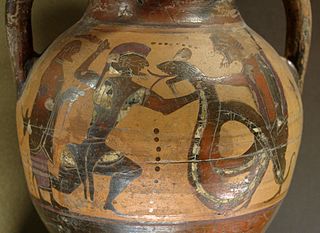
In Greek mythology, Cadmus was the legendary Phoenician founder of Boeotian Thebes. He was the first Greek hero and, alongside Perseus and Bellerophon, the greatest hero and slayer of monsters before the days of Heracles. Commonly stated to be a prince of Phoenicia, the son of king Agenor and queen Telephassa of Tyre, the brother of Phoenix, Cilix and Europa, Cadmus could trace his origins back to Zeus. Originally, he was sent by his royal parents to seek out and escort his sister Europa back to Tyre after she was abducted from the shores of Phoenicia by Zeus. In early accounts, Cadmus and Europa were instead the children of Phoenix. Cadmus founded the Greek city of Thebes, the acropolis of which was originally named Cadmeia in his honour.
In ancient Greek religion and mythology, Zagreus was sometimes identified with a god worshipped by the followers of Orphism, the "first Dionysus", a son of Zeus and Persephone, who was dismembered by the Titans and reborn. In the earliest mention of Zagreus, he is paired with Gaia and called the "highest" god, though perhaps only in reference to the gods of the underworld. Aeschylus, however, links Zagreus with Hades, possibly as Hades' son, or as Hades himself. Noting "Hades' identity as Zeus' katachthonios alter ego", Timothy Gantz thought it "likely" that Zagreus, perhaps originally the son of Hades and Persephone, later merged with the Orphic Dionysus, the son of Zeus and Persephone.

In Greek mythology, Ino was a mortal queen of Boeotia, who after her death and transfiguration was worshiped as a goddess under her epithet Leucothea, the "white goddess." Alcman called her "Queen of the Sea", which, if not hyperbole, would make her a doublet of Amphitrite.
In ancient Greek religion and mythology, Iacchus was a minor deity, of some cultic importance, particularly at Athens and Eleusis in connection with the Eleusinian mysteries, but without any significant mythology. He perhaps originated as the personification of the ritual exclamation Iacche! cried out during the Eleusinian procession from Athens to Eleusis. He was often identified with Dionysus, perhaps because of the resemblance of the names Iacchus and Bacchus, another name for Dionysus. By various accounts he was a son of Demeter, or a son of Persephone, identical with Dionysus Zagreus, or a son of Dionysus.

Ariadne was a Cretan princess in Greek mythology. She was mostly associated with mazes and labyrinths because of her involvement in the myths of the Minotaur and Theseus. She is best known for having helped Theseus escape the Minotaur but being abandoned by him on the island of Naxos; subsequently, she became the wife of Dionysus.

In Greek mythology, the Cabeiri or Cabiri, also transliterated Kabeiri or Kabiri, were a group of enigmatic chthonic deities. They were worshiped in a mystery cult closely associated with that of Hephaestus, centered in the north Aegean islands of Lemnos and possibly Samothrace—at the Samothrace temple complex—and at Thebes. In their distant origins the Cabeiri and the Samothracian gods may include pre-Greek elements, or other non-Greek elements, such as Thracian, Tyrrhenian, Pelasgian, Phrygian or Hittite. The Lemnian cult was always local to Lemnos, but the Samothracian mystery cult spread rapidly throughout the Greek world during the Hellenistic period, eventually initiating Romans.

In Greek mythology, Meleager was a hero venerated in his temenos at Calydon in Aetolia. He was already famed as the host of the Calydonian boar hunt in the epic tradition that was reworked by Homer. Meleager is also mentioned as one of the Argonauts.

A rhyton is a roughly conical container from which fluids were intended to be drunk or to be poured in some ceremony such as libation, or merely at table. They are typically formed in the shape of an animal's head, and were produced over large areas of ancient Eurasia, especially from Persia to the Balkans. Many have an opening at the bottom through which the liquid fell; others did not, and were merely used as drinking cups, with the characteristic that they could not usually be set down on a surface without spilling their contents.

The Dionysiaca is an ancient Greek epic poem and the principal work of Nonnus. It is an epic in 48 books, the longest surviving poem from Greco-Roman antiquity at 20,426 lines, composed in Homeric dialect and dactylic hexameters, the main subject of which is the life of Dionysus, his expedition to India, and his triumphant return to the west.

In Greek mythology and religion, the thiasus, was the ecstatic retinue of Dionysus, often pictured as inebriated revelers. Many of the myths of Dionysus are connected with his arrival in the form of a procession. The grandest such version was his triumphant return from "India", which influenced symbolic conceptions of the Roman triumph and was narrated in rapturous detail in Nonnus' Dionysiaca. In this procession, Dionysus rides a chariot, often drawn by big cats such as tigers, leopards, or lions, or alternatively elephants or centaurs.

The Dionysian Mysteries were a ritual of ancient Greece and Rome which sometimes used intoxicants and other trance-inducing techniques to remove inhibitions and social constraints, liberating the individual to return to a natural state. It also provided some liberation for men and women marginalized by Greek society, among which were slaves, outlaws, and non-citizens. In their final phase the Mysteries shifted their emphasis from a chthonic, underworld orientation to a transcendental, mystical one, with Dionysus changing his nature accordingly. By its nature as a mystery religion reserved for the initiated, many aspects of the Dionysian cult remain unknown and were lost with the decline of Greco-Roman polytheism; modern knowledge is derived from descriptions, imagery and cross-cultural studies.
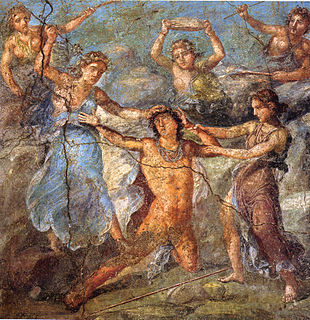
Sparagmos is an act of rending, tearing apart, or mangling, usually in a Dionysian context.
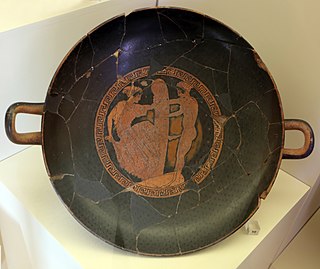
Haloa or Alo (Ἁλῶα) was an Attic festival, celebrated principally at Eleusis, in honour of Demeter, protector of the fruits of the earth, of Dionysus, god of the grape and of wine, and Poseidon, god of the seashore vegetation. In Greek, the word hálōs (ἅλως) from which Haloa derives means “threshing-floor” or “garden.” While the general consensus is that it was a festival related to threshing—the process of loosening the edible part of cereal grain after harvest—some scholars disagree and argue that it was instead a gardening festival. Haloa focuses mainly on the “first fruits” of the harvest, partly as a grateful acknowledgement for the benefits the husbandmen received, partly as prayer that the next harvest would be plentiful. The festival was also called Thalysia or Syncomesteria.
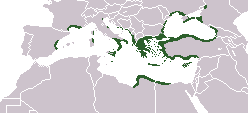
The influence of wine in ancient Greece helped ancient Greece trade with neighboring countries and regions. Many mannerisms and cultural aspects were associated with wine. It led to great change in Ancient Greece as well.
The peoples of the Mediterranean began to emerge from barbarism when they learned to cultivate the olive and the vine.
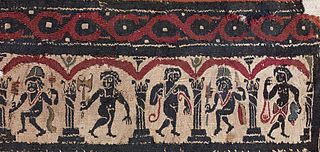
The cult of Dionysus was strongly associated with satyrs, centaurs, and sileni, and its characteristic symbols were the bull, the serpent, tigers/leopards, the ivy, and the wine. The Dionysia and Lenaia festivals in Athens were dedicated to Dionysus, as well as the phallic processions. Initiates worshipped him in the Dionysian Mysteries, which were comparable to and linked with the Orphic Mysteries, and may have influenced Gnosticism. Orpheus was said to have invented the Mysteries of Dionysus.

















